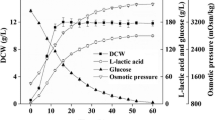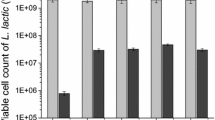Abstract
The aim of this study was to unravel the identity of compatible solutes accumulated by Lactobacillus plantarum subjected to osmotic stress. Betaine was accumulated simulataneously with a novel compatible solute identified as carnitine, both present in the complex medium applied in this study. Beef extract provided the main source of carnitine in the medium. Both carnitine and betaine were accumulated to maximum concentrations of 248 and 231 μmol.g dry weight-1, respectively. A defined medium was devised devoid of carnitine. Addition of 0.5 mM carnitine to this medium increased the growth rate from 0.1 h-1 to 0.2 h-1 in media with 0.4 M sodium chloride. Also, carnitine made the organism more tolerant to sodium chloride. Growth occurred even when the sodium chloride concentration was raised from 0.5 M to 1.0 M. Quaternary compounds resembling the structure of carnitine and betaine enhanced the growth yield as well. γ-Butyrobetaine and succinylcholine restored the growth yield up to respectively 91 and 96% compared to non-stressed cells.
Similar content being viewed by others
Abbreviations
- MRS :
-
De Man, Rogosa and Sharpe (De Man et al. 1960)
References
Arakawa T, Timasheff SN (1985) The stabilization of proteins by osmolytes. Biophys J 47:411–414
Bligh EG, Dyer WJ (1959) A rapid method of total lipid extracting and purification. Can J Biochem Physiol 37:911–917
Brown AD (1976) Microbial water stress. Bacteriol Rev 40: 803–846
Crowe JH, Crowe LM, Carpenter JF (1987) Stabilization of dry phospholipid bilayers and proteins by sugars. Biochem J 242:1–10
Csonka LN (1989) Physiological and genetic responses of bacteria to osmotic stress. Microbiol Rev 53:121–147
De Man JC, Rogosa M, Sharpe ME (1960) A medium for the cultivation of lactobacilli J Appl Bacteriol 23:130–135
Dinnbier U, Limpinsel E, Schmid R, Bakker EP (1988) Transient accumulation of potassium glutamate and its replacement by trehalose during adaptation of growing cells of Escherichia coli K-12 to elevated sodium chloride concentrations. Arch Microbiol 150:348–357
D'Souza-Ault MR, Tombras Smith L, Smith GM (1993) Roles of N-acetylgutaminylglutamine and glycine betaine in adaptation of Pseudomonas aeruginosa to osmotic stress. Appl Environ Microbiol 59:473–478
Fraenkel G (1954) The distribution of vitamin Bτ (carnitine) throughout the animal kingdom. Arch Biochem Biophys 50:486–495
Galinski EA Herzog RM (1990) The role of trehalose as a substitute for nitrogen-containing compatible solutes. Arch Microbiol 153:607–613
Galinski EA, Pfeiffer HP, Trüper HG (1985) 1,4,5,6-tetrahydro-2-methyl-4-pyrimidine carboxylic acid — a novel amino acid from halophilic phototrophic bacteria of the genus Ectothiorhodospira. Eur J Biochem 149:135–139
Hutkins RW, Ellefson WL, Kashket ER (1987) Betaine transport imparts osmotolerance on a strain of Lactobacillus acidophilus. Appl Environ Microbiol 53:2275–2281
Kets EPW, Bont JAM de (1994) Protective effect of betaine on survival of Lactobacillus plantarum subjected to drying. FEMS Microbiol Lett 116:251–256
Ko R, Tombras Smith L, Smith GM (1994) Glycine betaine confers enhanced osmotolerance and cryotolerance on Listeria monocytogenes. J Bacteriol 176:426–431
Larsen PI, Sydnes LK, Strøm AR (1987) Osmoregulation in Escherichia coli by accumulation of organic osmolytes: betaines, glutamic acid, and trehalose. Arch Microbiol 147:1–7
Le Rudulier D, Bernard T, Goas G, Hamelin J (1984) Osmoregulation in Klebsiella pneumoniae: enhancement of anaerobic growth and nitrogen fixation under stress by proline betaine, γ-butyrobetaine, and other related compounds. Can J Microbiol 30:299–305
Lippert K, Galinski EA (1992) Enzyme stabilization by ectoinetype compatible solutes: protection against heating, freezing and drying. Appl Microbiol Biotechnol 37:61–65
Miller KJ, Zelt SC, Bae J (1991) Glycine betaine and proline are the principal compatible solutes of Staphylococcus aureus. Curr Microbiol 23:131–137
Molenaar D, Hagting A, Alkema H, Driessen AJM, Konings WN (1993) Characteristics and osmoregulatory roles of uptake systems for proline and glycine betaine in Lactococcus lactis. J Bacteriol 175:5438–5444
Peters P, Tel-Or E, Trüper (1992) Transport of glycine betaine in the extremely haloalkaliphilic sulphur bacterium Ectothiorhodospira halochloris. J Gen Microbiol 138:1993–1998
Sakaguchi K (1962) Carnitine as a growth factor for Pediococcus soyae. Part x. Studies on the activities of bacteria in soy sauce brewing. Agric Biol Chem 26:72–74
Severin J, Wohlfarth A, Galinski EA (1992) The predominant role of recently discovered tetrahydropyrimidines for the osmoadaptation of halophilic eubacteria. J Gen Microbiol 138:1629–1638
Van Eck JH, Prior BA, Brandt EV (1993) The water relations of growth and polyhydroxy alcohol production by ascomycetous yeasts. J Gen Microbiol 139:1047–1054
Van Laere A (1989) Trehalose, reserve and/or stress metabolite? FEMS Microbiol Rev 63:201–210
Welsh DT, Reed RH, Herbert RA (1991) The role of trehalose in the osmoadaptation of Escherichia coli NCIB 9484: interaction of trehalose, K+ and glutamate during osmoadaptation in continuous culture. J Gen Microbiol 137:745–750
Wohlfarth A, Severin J, Galinski EA (1990) The spectrum of compatible solutes in heterotrophic halophilic eubacteria of the family Halomonadaceae. J Gen Microbiol 136:705–712
Yancey PH, Clark ME, Hand SC, Bowlus RD, Somero GN (1982) Living with water stress: evolution of osmolyte systems. Science 217:1214–1222
Author information
Authors and Affiliations
Rights and permissions
About this article
Cite this article
Kets, E.P.W., Galinski, E.A. & de Bont, J.A.M. Carnitine: a novel compatible solute in Lactobacillus plantarum . Arch. Microbiol. 162, 243–248 (1994). https://doi.org/10.1007/BF00301845
Received:
Accepted:
Issue Date:
DOI: https://doi.org/10.1007/BF00301845




